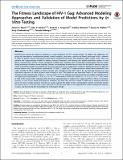| dc.contributor.author | Mann, Jaclyn K. | |
| dc.contributor.author | Barton, John P. | |
| dc.contributor.author | Ferguson, Andrew L. | |
| dc.contributor.author | Omarjee, Saleha | |
| dc.contributor.author | Walker, Bruce D. | |
| dc.contributor.author | Ndung'u, Thumbi | |
| dc.contributor.author | Chakraborty, Arup K | |
| dc.date.accessioned | 2014-10-20T14:36:51Z | |
| dc.date.available | 2014-10-20T14:36:51Z | |
| dc.date.issued | 2014-08 | |
| dc.date.submitted | 2013-10 | |
| dc.identifier.issn | 1553-7358 | |
| dc.identifier.issn | 1553-734X | |
| dc.identifier.uri | http://hdl.handle.net/1721.1/90985 | |
| dc.description.abstract | Viral immune evasion by sequence variation is a major hindrance to HIV-1 vaccine design. To address this challenge, our group has developed a computational model, rooted in physics, that aims to predict the fitness landscape of HIV-1 proteins in order to design vaccine immunogens that lead to impaired viral fitness, thus blocking viable escape routes. Here, we advance the computational models to address previous limitations, and directly test model predictions against in vitro fitness measurements of HIV-1 strains containing multiple Gag mutations. We incorporated regularization into the model fitting procedure to address finite sampling. Further, we developed a model that accounts for the specific identity of mutant amino acids (Potts model), generalizing our previous approach (Ising model) that is unable to distinguish between different mutant amino acids. Gag mutation combinations (17 pairs, 1 triple and 25 single mutations within these) predicted to be either harmful to HIV-1 viability or fitness-neutral were introduced into HIV-1 NL4-3 by site-directed mutagenesis and replication capacities of these mutants were assayed in vitro. The predicted and measured fitness of the corresponding mutants for the original Ising model (r = −0.74, p = 3.6×10[superscript −6]) are strongly correlated, and this was further strengthened in the regularized Ising model (r = −0.83, p = 3.7×10[superscript −12]). Performance of the Potts model (r = −0.73, p = 9.7×10[superscript −9]) was similar to that of the Ising model, indicating that the binary approximation is sufficient for capturing fitness effects of common mutants at sites of low amino acid diversity. However, we show that the Potts model is expected to improve predictive power for more variable proteins. Overall, our results support the ability of the computational models to robustly predict the relative fitness of mutant viral strains, and indicate the potential value of this approach for understanding viral immune evasion, and harnessing this knowledge for immunogen design. | en_US |
| dc.description.sponsorship | Ragon Institute of MGH, MIT and Harvard | en_US |
| dc.description.sponsorship | National Institutes of Health (U.S.) (Director's Pioneer Award) | en_US |
| dc.language.iso | en_US | |
| dc.publisher | Public Library of Science | en_US |
| dc.relation.isversionof | http://dx.doi.org/10.1371/journal.pcbi.1003776 | en_US |
| dc.rights | Creative Commons Attribution | en_US |
| dc.rights.uri | http://creativecommons.org/licenses/by/4.0/ | en_US |
| dc.source | Public Library of Science | en_US |
| dc.title | The Fitness Landscape of HIV-1 Gag: Advanced Modeling Approaches and Validation of Model Predictions by In Vitro Testing | en_US |
| dc.type | Article | en_US |
| dc.identifier.citation | Mann, Jaclyn K., John P. Barton, Andrew L. Ferguson, Saleha Omarjee, Bruce D. Walker, Arup Chakraborty, and Thumbi Ndung’u. “The Fitness Landscape of HIV-1 Gag: Advanced Modeling Approaches and Validation of Model Predictions by In Vitro Testing.” Edited by Roland R. Regoes. PLoS Comput Biol 10, no. 8 (August 7, 2014): e1003776. | en_US |
| dc.contributor.department | Massachusetts Institute of Technology. Institute for Medical Engineering & Science | en_US |
| dc.contributor.department | Massachusetts Institute of Technology. Department of Chemical Engineering | en_US |
| dc.contributor.department | Massachusetts Institute of Technology. Department of Chemistry | en_US |
| dc.contributor.department | Massachusetts Institute of Technology. Department of Physics | en_US |
| dc.contributor.department | Ragon Institute of MGH, MIT and Harvard | en_US |
| dc.contributor.mitauthor | Barton, John P. | en_US |
| dc.contributor.mitauthor | Chakraborty, Arup K. | en_US |
| dc.relation.journal | PLoS Computational Biology | en_US |
| dc.eprint.version | Final published version | en_US |
| dc.type.uri | http://purl.org/eprint/type/JournalArticle | en_US |
| eprint.status | http://purl.org/eprint/status/PeerReviewed | en_US |
| dspace.orderedauthors | Mann, Jaclyn K.; Barton, John P.; Ferguson, Andrew L.; Omarjee, Saleha; Walker, Bruce D.; Chakraborty, Arup; Ndung'u, Thumbi | en_US |
| dc.identifier.orcid | https://orcid.org/0000-0003-1467-421X | |
| dc.identifier.orcid | https://orcid.org/0000-0003-1268-9602 | |
| mit.license | PUBLISHER_CC | en_US |
| mit.metadata.status | Complete | |
